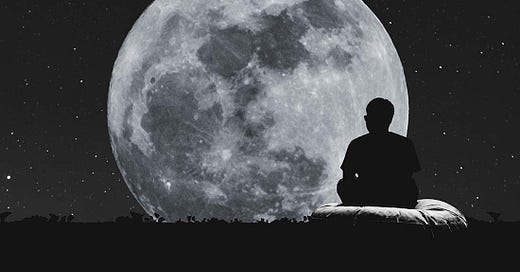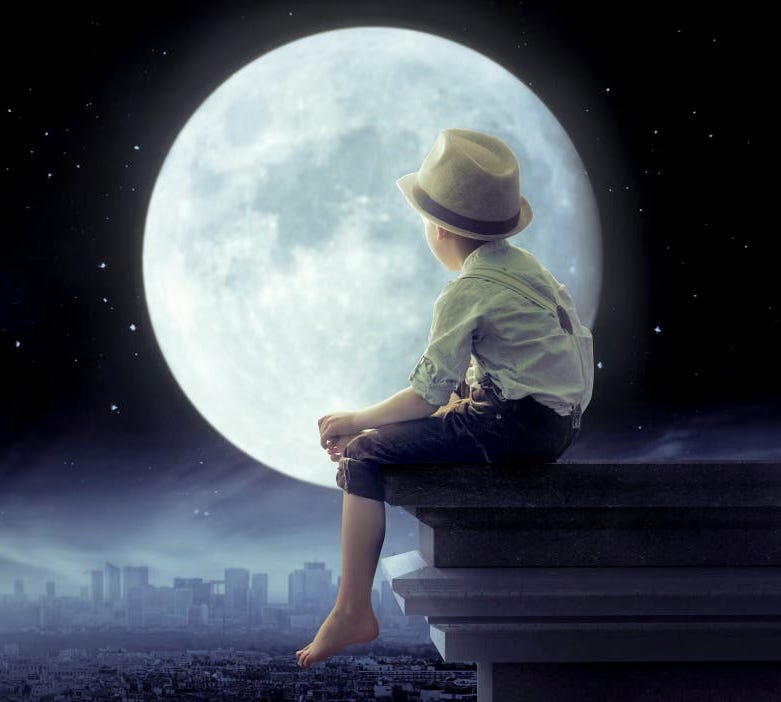Father Sun. Mother Moon
The poetry of Heavenly Bodies—How I see the Moon as "The Blessed Mother" and the Sun as God the Father. You may not see these celestial bodies the same way again after reading this.
I used to dabble in writing poetry. The shortest “poem” I’ve ever written, and one that I still hope to build on just a little bit, went this way,
“Father Sun. Mother Moon.”
Simple, but loaded. The Sun, with its burning heat and light too strong to observe with the naked eye, reminds me of God the Father, while the Moon, for many reasons, reminds me of the Virgin Mary. Still, today, when I look up at the night sky and see a beautiful moon, I salute it by saying, “Mother moon!” My little way of glorifying God for the work of his hands as well as saying, “Hi, Mamma” To the Holy Virgin—another creation of God that prompts my praise of Him.
I see more in the sun and moon than a single line of poetry conveys, and I wanted to share some of that with you today. Maybe you’ll never look at them the same way again.
"He made the sun to rule the day. For His love continues forever. He made the moon and stars to rule the night. For His love continues forever"
-Psalm 136:7-9
The moon’s light is not overpowering. It provides enough light to see and walk by, but not so much that it hurts eye eyes to look at it. It’s just right.
The Sun’s light is too overpowering to look at. Just as “no one can look upon the face of God and live.” We’re ill-equipped as human beings to direct our eyes to the sun. But we can stare at the moon all night long in the same way that Mary, a human being, just as we are, is easy to approach.
The Sun is a burning ball of light. By contrast, the moon has no light of its own. It reflects the light of the sun. The warmth of moonlight is only possible because of the sun. Mary also has no light of her own but reflects the light of the “son.” As great as the Blessed Mother is, her greatness is only possible because of the God who created her and the Son of God whose sacrifice on the cross won a special grace that preserved her from sin when she was conceived. (continues below)
The moon is a beautiful celestial object. But it’s scarred by craters that were probably caused by other celestial objects crashing into it. Paradoxically those craters are part of what makes the moon beautiful. Still, those scars are not natural to the moon but occurred, in a way, by the moon playing some role in protecting the earth. Some of those celestial bodies might have crashed into the earth were it not for the moon’s gravity and the moon itself interfering with their course.
Because the Holy Virgin was sinless, she did not merit death or even suffering. And yet she was subjected to some of the worst suffering imaginable in her seven dolors (or seven sufferings). In her role as the new Eve, who was “mother of all the living, Mary is the mother of all those who were given new life in Jesus Christ. As a mother, Mary took on sufferings she did not deserve, just as her Son undeservedly suffered for all humanity. Her sufferings became a part of her without being intrinsic to her being and nature. And, in a way, her suffering adds to the beauty of her person and her role in God’s plan for humanity. Our hearts go out to her more, for example, when we observe her suffering in great works like the Pieta.
The moon is much closer to the earth than the sun is, just as a mother is ever-close to her children. That isn’t to say God (the sun) isn’t close to humanity. As our creator and Heavenly Father, he is closest to humanity. But suppose we imagine the closeness of the moon and the son in relation to their respective greatness. In that case, we can imagine that God, who is vastly over and above the nature of humanity, is less “close” than the Virgin Mary, who is just a human being, as we are.
So the moon's closeness is proximal, just as our Blessed Mother is naturally close in proximity to her Children. But Mary is also close to us because she is fully human. She shares our nature and, unlike Jesus, has no divine nature.
We live amid the sun’s activity throughout the day as it rises and sets, passes over us and causes shadows to shift in direction and change in size. It almost seems as if the sun is active and even busy. Of course, this appearance of activity is caused by the Earth’s rotation rather than any real activity by the sun. But the moon, which orbits the earth, is actively moving, yet doesn’t give the same appearance of activity or busyness. The moon seems still. Though it moves from one part of the night sky to another, it seems to just “be there” without showing signs of activity, while the sun appears to be all over the sky, raining down its effects all over the earth. It makes itself known everywhere, throughout the day, by the direction and intensity of its light, and its position in the sky from east to west, causing shadows and erasing shade as it passes across the sky. “Mother Moon” is simply there, gentle, quiet, still, and “watching her children.”
God the Father is always active. The effects of his grace and providence are seen everywhere. In a similar way, Jesus is more active throughout the Gospel than Mary is. And yet Mary is every present in the Gospel from beginning to end. She is active, but the nature of her activity is different; quiet and still, always accompanying her son, watching over him even to the Cross.
When I look at the moon, I’m gazing upon our Blessed Mother, not with my eyes, but through the vision of my heart and spirit. The sun is harder to approach. The light of Truth sometimes burns, but it also guides. When the sun is blindingly bright, I look to the moon to light my path. The moon, after all, reflects the light of the ‘Son’.
I hope to know you well and soon—dear Father Sun, dear mother moon!
(Hey that wasn’t half bad!)





